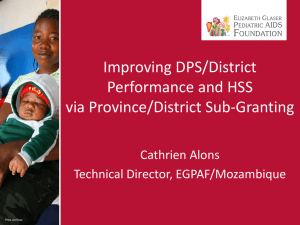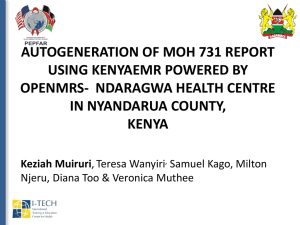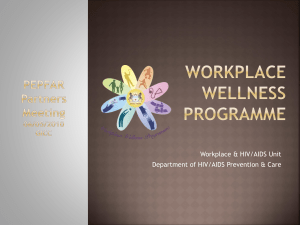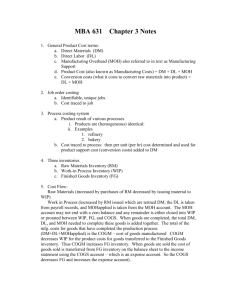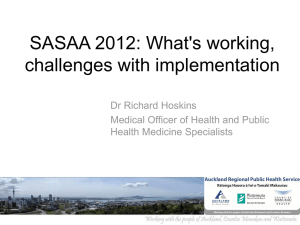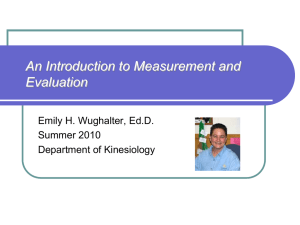Rozalin Wise, EGPAF - I-Tech
advertisement
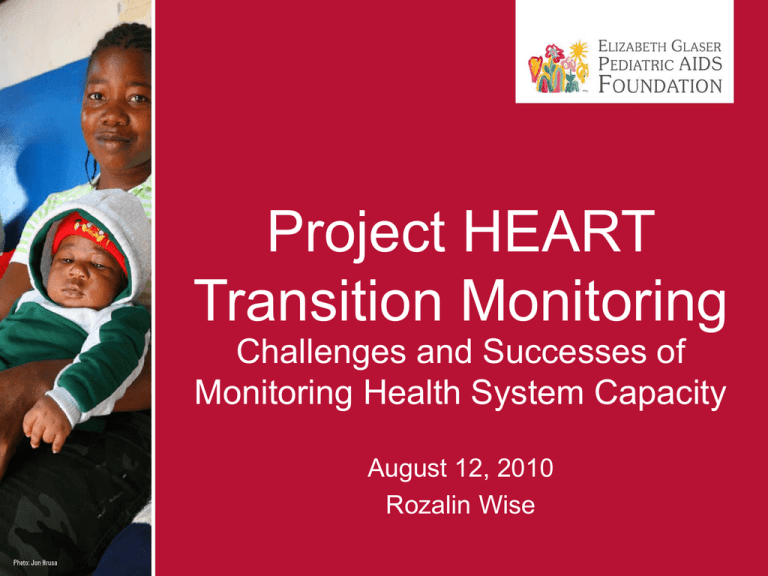
Project HEART Transition Monitoring Challenges and Successes of Monitoring Health System Capacity August 12, 2010 Rozalin Wise Transition Monitoring System: Goals • Document capacity of health system to meet HIV/AIDS Prevention, Care and Treatment needs pre, during and post transition • Increase monitoring of systems and processes to guide program interventions focused on health systems strengthening beyond site level • More uniform monitoring system across countries Transition Monitoring System: Design Overview • Capacity assessment of each Result area proposed in Transition Plan • Assessment scores transformed to same scale allowing plotting on spider diagram • Capacity assessments repeated annually at minimum 1. Health Outcomes 6. Enabling Environmen t 100 80 60 40 20 0 2. Health Service Provision 3. District Health Office Capacity 5. Community Capacity 4. Main Local NGO Capacity Baseline Final The Transition Vision: A strong house! Health Outcomes: Clients have continuous high quality Health Outcomes Health Outcomes HIV care and treatment delivered by (“the (“the roof”)roof”) local partners (the “roof”) Health Health Service Service Provision Provision (Quality&& (Quality Access) Access) RESULT11 RESULT Management Operational Capacity of Government, Government NGOs or Local & Private Organizations Sector managing health system Client and Community Client and Engagement Community Engagement (active civil society, RESULThigh 2 demand) RESULT 3 RESULT 2 Enabling Environment (the (“the“foundation”) foundation”) Policies, political stability, human rights, gender equality, etc. Transition Monitoring System: Design Overview Result Area Unit of Measure Assessment Tool/Process RESULT 1: Services Provision Health Facilities Site Capacity Profile (SCP) RESULT 2: Health System Management - District Health Authorities - Primary local NGO (transition partner) supporting systems strengthening - SCP/MoH Capacity Assessment - Organizational Capacity Assessment (OCVAT tool) RESULT 3: Community Linkage Key informants in health facility catchments areas SCP/Structured Interviews with CBOs and Support Groups Enabling Environment National Existing development/ policy indexes (policy, political stability, corruption, etc.) Transition Monitoring Timeline Assessment First Implementation OCVAT June - Sep 2010 Site Capacity Assessment Sep - Oct 2010 pilot Nov 2010 – Feb 2011 First Implementation Community Capacity Assessment Same as Site Capacity MOH Capacity Assessment Pending finalization of CDC H-CAT 2 Organizational Capacity: The OCVAT (Organizational Capacity and Viability Assessment Tool) • Semi-quantitative: Each indicator scored on 1-5 scale, representing stages of capacity • Implementation: Two phases – External Assessment – conducted by EGPAF Global – Self-Assessment – facilitated workshop w/ staff representing all departments/functions • External evaluators give scores • Participating staff give scores, median = official score • Results presentation: Compare scores, highlight strengths, weaknesses, discussion • External facilitator decides final scores if no consensus Service Provision: Site Capacity Profile (SCP) • Capacity Areas: ART, PMTCT, Peds, Treatment Support, Pharmacy, Laboratory Services, M&E/Reporting, Quality Improvement Program, Finance • Measures infrastructure, staffing and management/provision of services for each capacity area • Coupled with existing Quality of Care measures • Score generated per capacity area • Implementation: Program Officers complete using existing routine data, visit site to collect the rest OR use as QI activity with site QI Committee MOH Capacity Assessment • Will be based on CDC MOH Capacity Assessment tool • Working Group with representation from all EGPAF Project HEART countries will adapt ensuring necessary country context specification and comparability to extent possible Community Capacity Assessment • Focused on provision of support services • For key support services, measures core competencies: – Availability, Quality, Linkage (referral process), Utilization Barriers – Rapid – each competency, a few key questions • Informants: Site Staff, CBO Leaders, Support Groups • Countries decide which support services to focus on (modules developed for all) Conclusion • Series of capacity assessments capture health system’s capacity to provide continuous quality HIV/AIDS care and treatment • Demonstrates relationship of key components and their contribution to the whole Thank you!
